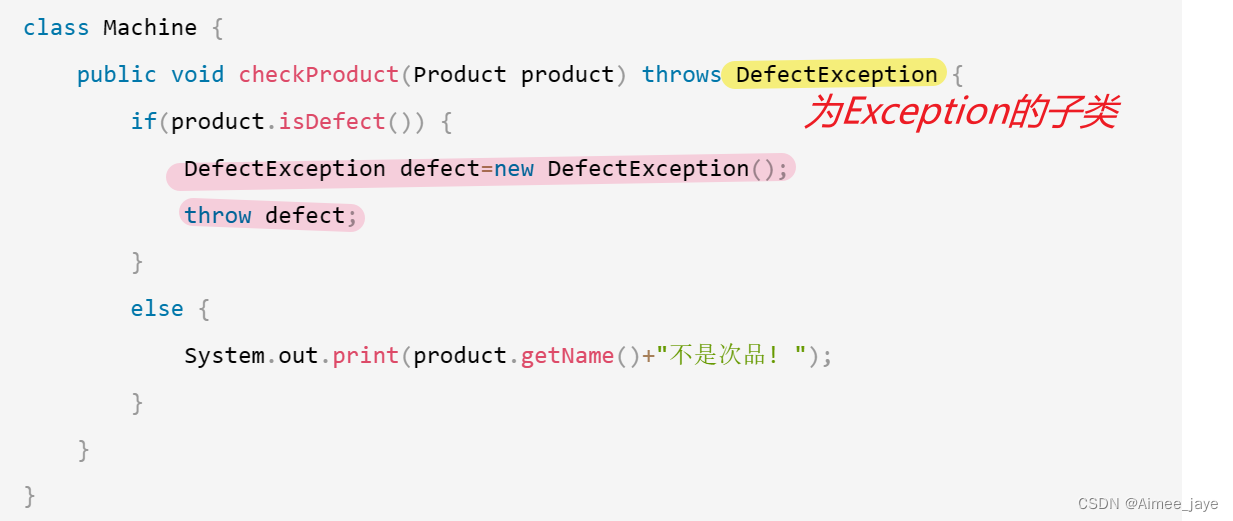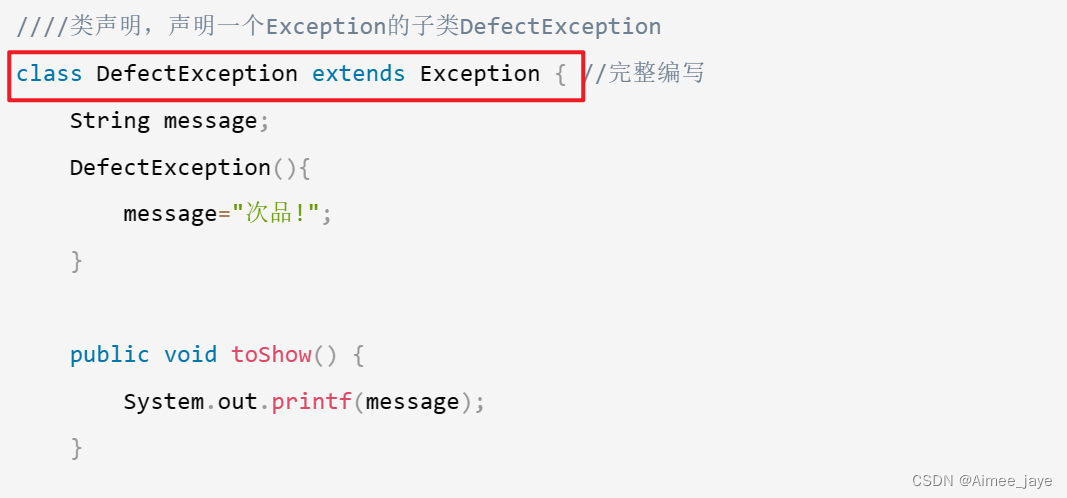知识点
如果try捕获到异常,则会与和它匹配的catch中的异常类型依次进行比对,如果相同则进行处理;如果不匹配,则继续匹配后续的catch类型;如果都不匹配,那么表示该异常无法由catch块处理,需要采用JVM默认的异常处理方式进行处理。最后不管有没有异常,都会执行finally中的语句块。
当使用的时候,try 语句是必须的;catch(err) 里面的参数是必须的; catch 和 finally 都是可选的。
三种形式
try...catch
try...finally
try...catch..finally
关于return的问题
若把 return 写入到了函数的 finally 里面,则最终函数(整个try/catch/finally)的返回值(或者抛出的异常)将是 finally 里面返回的值,即使前面 try/catch 出现了 retrun
throw 关键字
throw 语句与异常类型一起使用。 Java 中有许多异常类型可用: ArithmeticException, FileNotFoundException, ArrayIndexOutOfBoundsException, SecurityException, etc;
throw 语句用来直接拋出一个异常,后接一个可拋出的异常类对象,其语法格式如下:
throw ExceptionObject;
其中,ExceptionObject 必须是 Throwable 类或其子类的对象
如果是自定义异常类,也必须是 Throwable 的直接或间接子类。例如,以下语句在编译时将会产生语法错误:
throw new String("拋出异常"); // 因为String类不是Throwable类的子类
//实例
//如果年龄低于 18 岁,则抛出异常(打印"访问被拒绝")。如果年龄为 18 岁或以上,请打印"访问权限":
public class MyClass {
static void checkAge(int age) {
if (age < 18) {
throw new ArithmeticException("Access denied - You must be at least 18 years old.");
}
else {
System.out.println("Access granted - You are old enough!");
}
}
public static void main(String[] args) {
checkAge(15); // 将年龄设置为 15 岁(低于 18 岁......)
}
}
throws 关键字
通常在一个方法(类)的声明处通过 throws 声明方法(类)可能拋出的异常信息,而在方法(类)内部通过 throw 声明一个具体的异常信息。
throw用在方法实现中,而throws用在方法声明中;
throw只能用于抛出一种异常,而throws可以抛出多个异常
public class Example {
public static void main(String[] args) {
try {
int result = divide(4,2);
System.out.println(result);
} catch (Exception e) {
e.printStackTrace();
}
}
public static int divide(int x,int y) throws Exception
{
int result = x/y;
return result;
}
}
例子
package org.example;
//类声明,声明一个Exception的子类NoLowerLetter
class NoLowerLetter extends Exception {
public void print() {
System.out.printf("%c",'#');
}
}
//类声明,声明一个Exception的子类NoDigit
class NoDigit extends Exception {
public void print() {
System.out.printf("%c", '*');
}
}
class People {
void printLetter(char c) throws NoLowerLetter {
if (c < 'a' || c > 'z') {
NoLowerLetter noLowerLetter = new NoLowerLetter();//创建NoLowerLetter类型对象
throw noLowerLetter;
} else {
System.out.print(c);
}
}
void printDigit(char c) throws NoDigit{
if (c < '1' || c > '9') {
NoDigit noDigit = new NoDigit();
throw noDigit;
} else {
System.out.print(c);
}
}
}
public class Main{
public static void main(String[] args) {
People people=new People();
for(int i=0;i<128;i++) {
try {
people.printLetter((char)i);
}
catch(NoLowerLetter e) {
e.print();
}
}
for(int i=0;i<128;i++) {
try {
people.printDigit((char)i);
}
catch(NoDigit e) {
e.print();
}
}
}
}
例题1
检查物品是否为次品
工厂检查产品次品的设备,如果发现是次品就发出警告。编程模拟设备发现次品过程。
编写一个产品类Product,有成员变量name和isDefect(是否次品),有get和set方法。
编写一个Exception的子类DefectException,该子类message属性,有构造方法DefectException() 将"次品"赋值给message成员,有toShow()方法输出message的值
编写一个Machine类,该类的方法checkProduct(Product product)当发现参数product为次品时(product的 isDefect属性为true),将抛出DefectException异常对象。
程序在主类的main方法中的try…catch语句的try部分让Machine类的实例调用checkProduct方法,如果发现次品就在try…catch语句的catch部分处理次品。
输入样例
电脑 炸药 西服 硫酸 手表 硫磺
输出样例
电脑不是次品! 电脑检查通过
次品!炸药被禁止!
西服不是次品! 西服检查通过
次品!硫酸被禁止!
手表不是次品! 手表检查通过
次品!硫磺被禁止!
import java.util.Scanner;
public class Main {
public static void main(String[] args) {
Machine machine = new Machine();
String name[] ;
Scanner sc=new Scanner(System.in);
name=sc.nextLine().split(" ");
Product [] products = new Product[name.length]; //检查6件货物
for(int i= 0;i<name.length;i++) {
products[i] = new Product();
if(i%2==0) {
products[i].setIsDefect(false);
products[i].setName(name[i]);
}
else {
products[i].setIsDefect(true);
products[i].setName(name[i]);
}
}
for(int i= 0;i<products.length;i++) {
try {
machine.checkProduct(products[i]);
System.out.println(products[i].getName()+"检查通过");
}
catch(DefectException e) {
e.toShow();//【代码2】 //e调用toShow()方法
System.out.println(products[i].getName()+"被禁止!");
}
}
}
}
/* 将完整的Product类, DefectException类 和Machine类写在下面*/
题解
class Product { //完整编写
boolean isDefect;
String name;
public String getName() {
return name;
}
public void setName(String name) {
this.name = name;
}
public void setIsDefect(boolean b) {
this.isDefect=b;
}
public boolean isDefect() {
return isDefect;
}
//补充代码
}
类声明,声明一个Exception的子类DefectException
class DefectException extends Exception { //完整编写
String message;
DefectException(){
message="次品!";
}
public void toShow() {
System.out.printf(message);
}
}
class Machine {
public void checkProduct(Product product) throws DefectException {
if(product.isDefect()) {
DefectException defect=new DefectException();
throw defect;
}
else {
System.out.print(product.getName()+"不是次品! ");
}
}
}
例题2
异常-多种类型异常的捕获
如果try块中的代码有可能抛出多种异常,且这些异常之间可能存在继承关系,那么在捕获异常的时候需要注意捕获顺序。
补全下列代码,使得程序正常运行。
裁判测试程序
public static void main(String[] args) {
Scanner sc = new Scanner(System.in);
while (sc.hasNext()) {
String choice = sc.next();
try {
if (choice.equals("number"))
throw new NumberFormatException();
else if (choice.equals("illegal")) {
throw new IllegalArgumentException();
} else if (choice.equals("except")) {
throw new Exception();
} else
break;
}
/*这里放置你的答案*/
}//end while
sc.close();
}
输出说明
在catch块中要输出两行信息:
第1行:要输出自定义信息。如下面输出样例的number format exception
第2行:使用System.out.println(e)输出异常信息,e是所产生的异常。
输入样例
number illegal except quit
输出样例
number format exception
java.lang.NumberFormatException
illegal argument exception
java.lang.IllegalArgumentException
other exception
java.lang.Exception
题解
catch (NumberFormatException e){
System.out.println("number format exception");
System.out.println(e);
} catch (IllegalArgumentException e){
System.out.println("number argument exception");
System.out.println(e);
}
catch (Exception e) {
System.out.println("other exception");
System.out.println(e);
}
总结


!!!
出现多种异常时,Exception 必须放最后
多个异常类型必须是从小到大排列,即父类异常必须放在子类异常之后,这是因为Java会优先匹配catch语句的第一个参数。






















 657
657











 被折叠的 条评论
为什么被折叠?
被折叠的 条评论
为什么被折叠?








